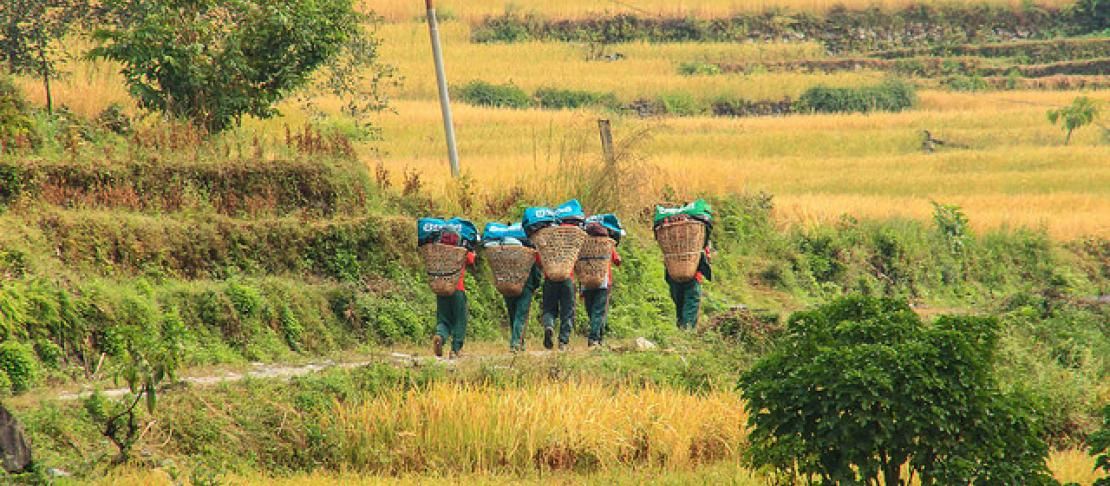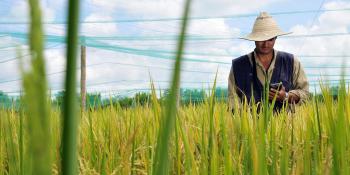Forecasting in-season wheat and paddy yields: emerging results from Nepal

The CCAFS Regional Agriculture Crop Forecasting Toolkit (CRAFT) was deployed and tested to estimate in-season crop yields for wheat and paddy in Nepal.
A major part of tackling climate change and climate variability is grappling with and reducing uncertainties wherever possible. In countries where food security is at risk, climate change exacerbates the unpredictability of crop yields for a given season. This could have dire consequences on the food security of the population, imports-exports, food prices and on people’s livelihoods. However, with advances in crop-forecasting technology and crop modeling, it is now possible for researchers to estimate in-season crop yields under a variable climate so as to allow decision-makers and planners to better prepare for the risks emerging from climate change.
This is particularly true for countries in South Asia where agriculture remains vulnerable to climate change and a large population depends on it for their livelihood and food security.
CCAFS South Asia and the CCAFS Flagship 2 on Climate Risk Management have developed an open source, flexible crop-forecasting platform that includes a crop simulation module (DSSAT), a weather and seasonal forecast simulation module, and a geographic information system module. The toolkit can help determine advance information on in-season crop yields, thus enabling researchers, planners and food security experts to make informed decisions. The process of developing the toolkit has been participatory with several stakeholder workshops held in Nepal and India in the last four years.
Read a brochure on the CRAFT toolkit
Forecasting yields through crop-cutting samples and surveys
Typically, in Nepal, the government undertakes efforts to estimate crop yields by relying on traditional crop cuts, surveys and field verification reports from the District Agriculture Development Offices. Based on the data and information gathered from these exercises, the government, along with the World Food Programme (WFP) and the Food and Agriculture Organization of the United Nations (FAO), releases two reports on the Crop Situation Update after the harvest. While this process has many advantages, it is slow and expensive and does not offer real-time information on the crop situation so that planning can be timely and strategic.
Moving to real-time forecasts for wheat and paddy
Working with a range of partners in Nepal, the CCAFS Regional Agriculture Crop Forecasting Toolkit (CRAFT), was deployed and tested for two in-season crop seasons to estimate in-season crop yields for wheat and paddy.
The Nepal Food Security Monitoring System (NeKSAP), an initiative started by the World Food Programme and now being institutionalized by the Government of Nepal, has documented preliminary results and made this available through two reports.
Mr. Hemraj Regmi, National Coordinator, NeKSAP and undersecretary at the MoAD said:
The Ministry was using crop observation and crop cutting surveys to estimate crop production, which are costly and time consuming. Since last two crop seasons we are using CRAFT toolkit in addition to the previous techniques. The results from this toolkit are close to MoAD’s observed data and are near within 90 to 95 percent confidence limits from the field estimation. Since the CRAFT estimates are so close we can shift towards these techniques for production estimation, which are time and cost effective and the results are available well in advance; before the crop harvest.
This report relies on information provided by different agencies, including the International Centre for Integrated Mountain Development (ICIMOD), International Water Management Institute (IWMI), International Research Institute for Climate and Society (IRI) at Columbia University, Nepal Agriculture Research Council (NARC), Department of Agriculture, Ministry of Agriculture Development, and the World Food Programme (WFP). The results from these two projections are available on the website of the Nepal Food Security Monitoring System.
Read the full reports:
Further reading
Stakeholders learn new features of yield forecasting toolkit
The toolkit is also being tested in other countries in South Asia such as Bangladesh and Sri Lanka.
Paresh Bhaskar works for CCAFS South Asia; Dhiraj Gyawali works for World Food Program



